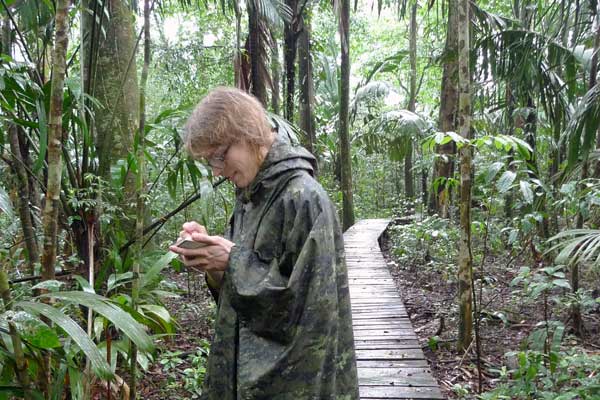
Monkeys for alarm clocks – a biodiversity expedition in the tropical rainforest
Published: April 23, 2015
It’s not every day you get a chance to use the rainforest as a laboratory, waking up each morning to the distant calls of howler monkeys as your alarm clock.
A group of eight students under the supervision of U of T Scarborough professor Nathan Lovejoy recently did just that, getting hands-on research training in a tropical jungle. (See a photo gallery of the experience.)
The students were part of a recent field course biodiversity expedition to the Caño Palma Biological Station in the heart of the Costa Rican tropical rainforest. They were there to study the area’s biodiversity with a focus on collecting freshwater fish specimens that will become part of museum collections in Canada and Costa Rica.
 “Living directly in an environment is the best way to learn about that environment,” says Susanna Shu, a third-year cell and molecular biology student at UTSC who took part in the expedition.
“Living directly in an environment is the best way to learn about that environment,” says Susanna Shu, a third-year cell and molecular biology student at UTSC who took part in the expedition.
Shu enjoyed the challenge of collecting fish samples, especially learning the techniques used in catching fish while negotiating the swampy habitats. She will also remember waking up to catch the tropical sunrise and watching hundreds of tropical shorebirds feeding along the river bank.
“I think when you’re surrounded by such a beautiful landscape it drives your curiosity and motivates you to learn more than simply reading about it in a textbook,” she says.
The station, established in 1990 by a Canadian couple working for the Toronto Zoo and operated by the non-profit Canadian Organization for Tropical Education and Rainforest Conservation (COTERC), offers a venue for learning how to properly conduct a research expedition. Students also take part in various biodiversity surveys offered at the station.
Caño Palma is located in the Atlantic lowlands on the eastern coast of Costa Rica. Much of the surrounding area is protected under the country’s parks and reserves system, with Tortuguero National Park and the Barra Colorado Refuge forming a vast corridor that connects to preserved forest in Nicaragua to the north.
“There is incredible aquatic biodiversity in the area,” says Lovejoy. “One ongoing concern is run-off from nearby agricultural production that is putting insecticide into the water.
 “The samples collected by our students will add to a good baseline of collections that have been made over the years.”
“The samples collected by our students will add to a good baseline of collections that have been made over the years.”
The expedition was anything but a week away in the sun, notes Lovejoy. After landing in San Jose and taking a bus through the mountains to La Pavana, a place where “the road ends,” the group travelled by boat to the field station situated in a swampy area of the rainforest.
The conditions in the area are extremely hot and humid, with some of the heaviest rainfall in all of Costa Rica, often exceeding 6,000 mm annually.
Living facilities in the 43-acre station are clean and comfortable but basic. Volunteers, researchers and students share a dormitory that can accommodate 30 people. A large airy dining room connects to the kitchen and office, which is the central meeting area for the station.
It’s the second time Lovejoy has undertaken an expedition to the area and the samples collected will complement those previously taken. His studies will help the Costa Rican government in their efforts to understand and protect the biodiversity of the area.
What stood out the most for Lovejoy was how motivated his students were in collecting samples.
“The biodiversity in the area could be very different in the future,” says Anne Benaroya, a student in the Masters of Environmental Science program at UTSC.
She was most impressed with the research skills she was able to develop, which left a greater impact knowing the samples she gathered will be put to good use.
“It’s cool to think that in 50 years from now the only way of knowing what was once there could be from our work.”

Don Campbell is a writer with the University of Toronto Scarborough.



